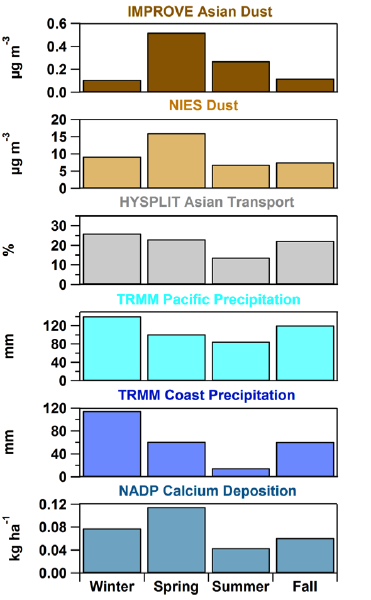Publication Notice
5 December 2014
A journal article entitled Climatology of Long-Range Transported Asian Dust along the West Coast of the United States by Jessie M. Creamean, J. Ryan Spackman, Sean M. Davis, and Allen B. White, was published in the November 2014 issue of the Journal of Geophysical Research – Atmospheres.
The contribution of trans-Pacific dust estimated from satellite observations has been shown to be three times greater than domestic dust in North America throughout the year. Mineral dust aerosols affect weather and climate by influencing Earth’s radiative balance and altering cloud properties, among other environmental and ecological effects. Thus, a quantitative understanding of the frequency and locations where Asian dust is transported is necessary to improve global dust modeling for weather and climate predictions.
This paper presents a 10-year record (2002-2011) of dust along the U.S. west coast estimated from the Interagency Monitoring of Protected Visual Environments (IMPROVE) network in an effort to characterize the seasonal cycle and interannual variability of Asian dust transport. In addition, observations of dust exported from East Asia were analyzed along with air mass trajectories and satellite and ground-based precipitation data to investigate seasonal variability of Asian dust transport. On average, Asian dust concentrations from ground-based observations were 1.7 times those of local dust and 23% (up to 44%) of PM2.5 mass concentrations at high elevations in the spring. The maximum in springtime Asian dust on the U.S. west coast was attributed to higher source concentrations and reduced potential for wet removal over the Pacific Ocean and U.S. west coast. Although trans-Pacific transport was more favorable during the winter, minimum concentrations of Asian dust were observed on the U.S. west coast due to a lower source influence and higher potential for wet removal during transport. Multi-observational approaches such as these should be taken into account when modeling transport of Asian dust to the western U.S.
Gaining a better understanding of the transport of Asian dust has important implications for assessing dust aerosol impacts on clouds and precipitation in the western U.S. The U.S. west coast commonly experiences extreme precipitation events, particularly the mountain regions, which can lead to substantial consequences for the western U.S. water supply, including increased runoff, decrease in snowpack, and flooding. Further, dust aerosols can increase accumulated precipitation by 10-20%, and increase snow formation by ~40% in the Sierra Nevada during the winter season. A major interdisciplinary project, CalWater 2, has been planned along and offshore the U.S. west coast over the next five years. As one of its major thrusts, CalWater 2 will include aircraft, ship, and ground-based measurements to address aerosol impacts on extreme precipitation. Understanding all of the factors, including aerosols such as dust, that impact the hydrologic cycle on the U.S. west coast may aid in future water cycle resource availability predictions.
Contact: Jessie Creamean
